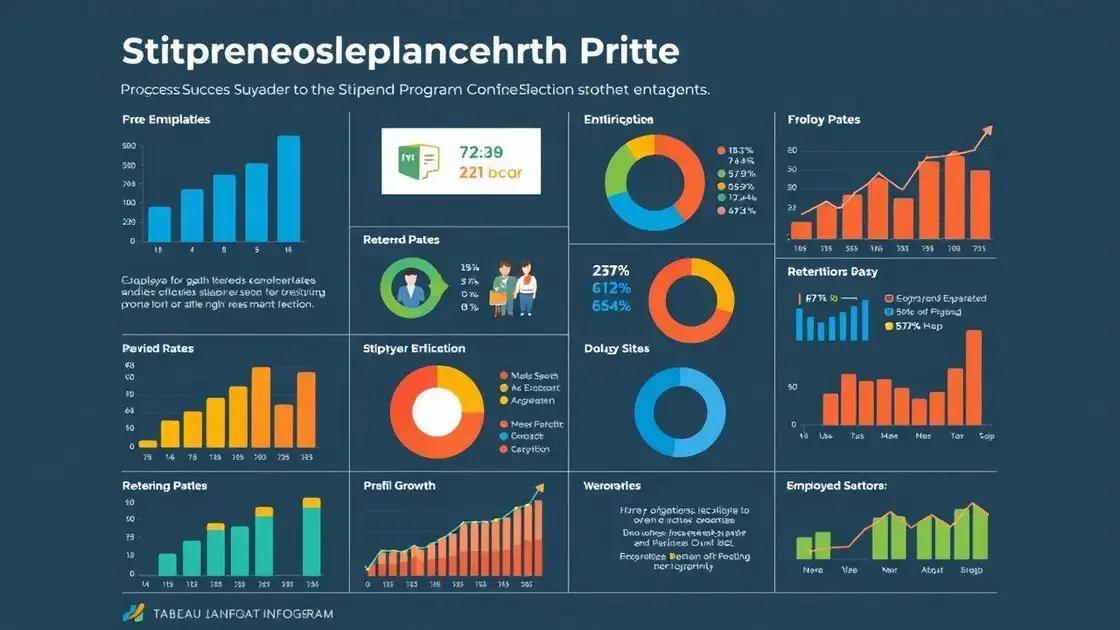Professional development stipends expansion: a must for growth

Professional development stipends are financial resources provided by employers to support employee education and training, enhancing motivation, skill development, and job satisfaction while benefiting organizational growth.
Professional development stipends expansion is becoming a key initiative for organizations looking to boost employee skills and satisfaction. Have you considered how such investment can transform your workplace? In this article, we’ll dive into the importance of these stipends and their direct benefits.
Understanding professional development stipends
Understanding professional development stipends is crucial for organizations aiming to enhance employee skills. These stipends offer financial support for training and development activities, which can lead to improved performance and satisfaction.
What Are Professional Development Stipends?
Professional development stipends are funds provided by employers to employees for educational purposes. This can include workshops, conferences, or courses that help enhance an employee’s skills or knowledge in their field.
Benefits of Stipends
- Increased Skill Development: Employees can acquire new skills that benefit the organization.
- Higher Job Satisfaction: Investing in employees leads to a more engaged workforce.
- Attracting Top Talent: Organizations offering stipends are often more appealing to potential hires.
Furthermore, providing stipends can foster a culture of continuous learning within the workplace. Employees feel valued when their growth is supported, leading to higher retention rates. When employees know that their company is invested in their success, it boosts morale and productivity.
Implementing Stipend Programs
When planning to implement a professional development stipend program, it’s essential to define clear guidelines. Determine the amount available, the types of training that qualify, and how employees can access these funds. This clarity helps ensure that the stipend is utilized effectively and benefits both the employees and the organization.
Moreover, organizations might consider conducting surveys to understand employees’ training needs better. By aligning stipends with employee interests, companies can ensure that training is not only relevant but also engaging. Providing options for different training formats, such as online courses or in-person workshops, can also enhance the program’s appeal.
Ultimately, a well-structured stipend program can significantly impact employee growth and organizational success.
The impact of stipends on employee motivation

The impact of stipends on employee motivation is significant and multifaceted. When organizations provide financial support for professional development, employees feel valued and recognized for their efforts.
How Stipends Increase Motivation
Professional development stipends can lead to increased motivation in several key ways. Firstly, they allow employees to pursue training that aligns with their career goals, fostering a sense of ownership over their career development. When individuals have the opportunity to enhance their skills, their job satisfaction tends to improve.
Key Motivational Benefits
- Empowerment: Employees feel empowered when they can select training that fits their personal interests.
- Increased Engagement: Financial support fosters a more engaged workforce as employees commit to their growth.
- Positive Company Culture: Stipends signal that the organization cares about its employees’ professional journeys.
Moreover, when employees know that their company invests in their future, they are more likely to remain loyal. This loyalty can translate into lower turnover rates. In addition, employees who benefit from stipends are often more productive and motivated, showcasing their enhanced skills and knowledge in their roles.
Establishing a stipend program requires careful planning. Companies should communicate the program’s details clearly to ensure that employees understand how they can utilize these funds. Regular feedback from employees about their training experiences can also help optimize the program, aligning it with their needs and preferences.
Ultimately, the influence of stipends on motivation demonstrates that organizations can create a nurturing environment where employees not only want to excel but actively seek out opportunities for growth.
Best practices for implementing stipends
When it comes to implementing professional development stipends, following best practices is essential to ensure success. These stipends can transform an organization’s approach to employee growth and satisfaction.
Define Clear Guidelines
Establishing clear guidelines for the stipend program is crucial. Organizations should outline the eligibility criteria, the types of training that qualify, and the application process. When employees know exactly how to access these funds, they are more likely to participate.
Types of Training to Include
- Conferences and Workshops: Encourage employees to attend industry conferences that enhance their skills.
- Online Courses: Offer stipends for employees to take online courses that are relevant to their work.
- Certifications: Support employees in pursuing professional certifications.
Moreover, companies should engage employees in identifying the training that they find beneficial. By doing so, it fosters a sense of contribution and encourages employees to take initiative in their own development. Regularly soliciting feedback about the stipend program helps to fine-tune the offerings and ensure they meet the evolving needs of the workforce.
In addition, promoting the stipend program effectively within the organization is vital. Use newsletters, meetings, and internal communications to remind employees about the available stipends and share success stories from colleagues who have utilized the program. This reinforces the value of the stipends and motivates others to take advantage of them.
Monitor and Evaluate the Program
Lastly, organizations should regularly monitor and evaluate the effectiveness of their stipend program. Metrics such as participation rates, employee satisfaction, and performance improvements can provide valuable insights. By analyzing these metrics, companies can adjust the program as necessary for optimal results.
Measuring the success of stipend programs

Measuring the success of stipend programs is essential to understand their impact on both employees and the organization. By tracking specific metrics, companies can assess how effective these programs are in driving employee growth and engagement.
Key Metrics to Consider
One of the primary metrics to evaluate is participation rate. Knowing how many employees take advantage of the stipends gives insight into their popularity and accessibility. Additionally, monitoring employee satisfaction through regular surveys can reveal how employees feel about the program.
Evaluating Outcomes
- Skill Improvement: Review employee performance before and after participating in training funded by stipends.
- Retention Rates: Track if employees who utilize stipends stay longer with the company.
- Career Advancement: Analyze if those who participate in stipend programs are promoted more frequently.
Incorporating qualitative data can also enrich the evaluation process. Employee testimonials about their training experiences can provide valuable insights into the program’s perceived value. Furthermore, companies should compare the performance of employees using stipends against those who do not. This comparison can highlight the tangible benefits of investing in employee development.
Another important aspect is benchmarking against industry standards. Understanding how your stipend program compares with others in your field can help identify areas for improvement. Regularly reviewing these metrics allows organizations to refine their stipend programs, ensuring they remain effective and relevant to employees’ needs.
Ultimately, measuring success goes beyond simple numbers. It fosters a culture of continuous improvement within the organization, leading to sustained employee engagement and growth.
FAQ – Frequently Asked Questions about Professional Development Stipends
What are professional development stipends?
Professional development stipends are funds provided by employers to support employees in pursuing educational opportunities, such as workshops, courses, or conferences.
How can stipends improve employee motivation?
Stipends empower employees to enhance their skills, leading to increased job satisfaction and engagement as they feel valued and invested in.
What metrics should organizations track to measure stipend success?
Organizations should track participation rates, employee satisfaction, skill improvement, and retention rates to evaluate the effectiveness of stipend programs.
What are some best practices for implementing stipend programs?
Define clear guidelines, promote the program effectively, collect employee feedback, and regularly evaluate outcomes to ensure continuous improvement.





